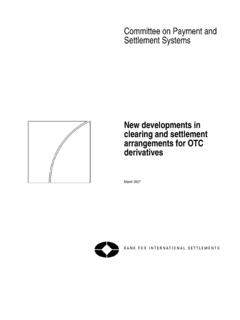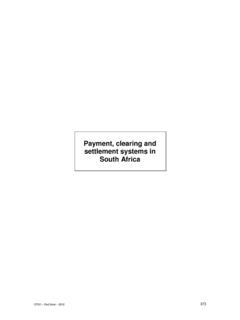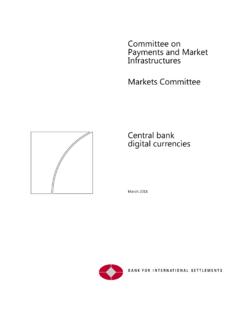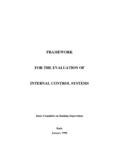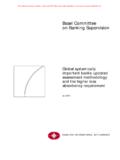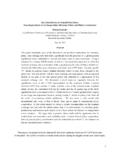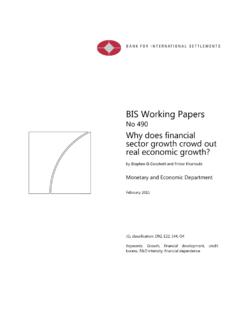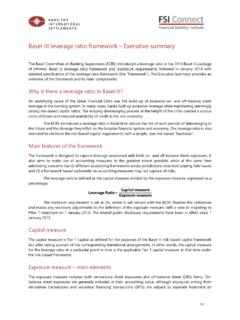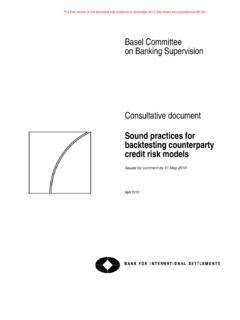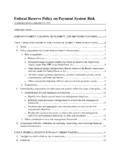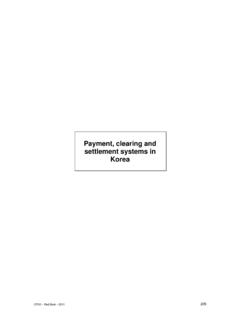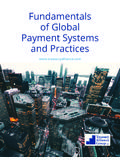Transcription of DELIVERY VERSUS PAYMENT IN SECURITIES SETTLEMENT SYSTEMS
1 BANK FOR INTERNATIONAL SETTLEMENTSDELIVERY VERSUS PAYMENTINSECURITIES SETTLEMENT SYSTEMSR eport prepared by the Committee on PAYMENT and SETTLEMENT Systemsof the central banks of the Group of Ten countriesBasleSeptember 1992 Bank for International Settlements 1992. All rights reserved. Brief excerptsmay be reproduced or translated provided the source is 92-9131-114-6 Published also in French, German and of the DELIVERY VERSUS PAYMENT study and summary ..1 Introduction ..1 Summary ..2 Additional issues relating to cross-border SECURITIES transactions .. framework: Credit and liquidity risks in SECURITIES clearance and SETTLEMENT ..10 Key steps in clearance and SETTLEMENT ..10 Types and sources of risk ..12 The DELIVERY VERSUS PAYMENT principle .. structural approaches to DELIVERY VERSUS PAYMENT .
2 16 Identification of alternative models ..16 Model 1: Gross, simultaneous settlements of SECURITIES and funds transfers ..17 Model 2: Gross SETTLEMENT of SECURITIES transfers followed bynet SETTLEMENT of funds transfers ..20 Model 3: Simultaneous net SETTLEMENT of SECURITIES and funds transfers .. risk management issues and common safeguards: A synthesis ..25 Counterparty credit and liquidity risks ..25 Risk of failure of a SETTLEMENT bank, guarantor or custodian .. of implications of SECURITIES SETTLEMENT SYSTEMS for financial stability ..30 Legal basis for the system ..31 Understanding of risks ..32 Incentives and capabilities to manage risks ..33 Arrangements for ensuring timely completion of settlements ..34 Admission criteria ..37 Operational reliability ..37 Conclusions ..37 Annex 1: Group of Thirty recommendations regarding SECURITIES clearance and SETTLEMENT .
3 A1-1 Annex 2: Glossary .. A2-1 Annex 3: Key features of SECURITIES transfer SYSTEMS in the G-10 countries .. A3-1 Annex 4: Minimum standards for cross-border and multi-currency netting andsettlement schemes .. A4-1 ForewordThe worldwide collapse of equity prices in October 1987 heightened the awareness of central banks ofthe potential for disturbances in settlements of SECURITIES transactions to spread to PAYMENT systemsand to financial markets generally. Since then, central banks in the Group of Ten countries have beenworking with market participants and SECURITIES industry supervisors to strengthen settlementarrangements. In particular, most of the G-10 central banks have been actively involved in efforts toimplement the Group of Thirty s recommendations for strengthening and harmonising settlementarrangements for corporate SECURITIES as well as in efforts to strengthen SETTLEMENT arrangements forgovernment order to enhance central bank understanding of issues relating to SECURITIES SETTLEMENT SYSTEMS , theCommittee on PAYMENT and SETTLEMENT SYSTEMS reviewed and analysed arrangements in theG-10 countries at a meeting in Basle in December 1990.
4 At that meeting the Committee identified aneed for clearer understanding of the concept of DELIVERY VERSUS PAYMENT (DVP) and of theimplications of the design and operation of SYSTEMS intended to achieve DVP for credit and liquidityrisks in SECURITIES settlements. Shortly thereafter, a study group, chaired by Mr. P. Parkinson, wasformed to analyse these report is the outcome of the study group s efforts. The group has developed a broad frameworkfor analysing the types and sources of risk in SECURITIES clearance and SETTLEMENT , including the conceptand implications of DVP. Building on this framework, it has reviewed the design and operation ofsecurities SETTLEMENT SYSTEMS in use or under development in the G-10 countries, identified commonapproaches to DVP and evaluated the implications of the various approaches for central bank policyobjectives concerning the stability of financial markets and the containment of systemic risk.
5 Bypublishing the report the Committee hopes to contribute to the understanding of these issues andthereby to facilitate ongoing efforts to strengthen SECURITIES SETTLEMENT SYSTEMS in the G-10 countriesand in other report should be viewed solely as the product of study by the Committee on PAYMENT andSettlement SYSTEMS and does not necessarily represent the views of either the central banks of theG-10 countries or the Bank for International Settlements. Able assistance in editing, translating, andpublishing the report was provided by the D. Angell, ChairmanCommittee on PAYMENT and SETTLEMENT Systemsand Member of the Board of Governors,Federal Reserve SystemSeptember 1992 MEMBERS OF THE DELIVERY VERSUS PAYMENT STUDY GROUPC hairmanMr. Patrick Parkinson,Board of Governors of theFederal Reserve SystemNational Bank of BelgiumMr.
6 Charles LotsBank of EnglandMr. David WyattBank of FranceMr. Jo l M r reDeutsche BundesbankMr. Hans DetmeringMr. Dieter KrebsBank of ItalyMr. Giampietro D AndriaMr. Pietro StecconiBank of JapanMr. Taku OizumiNetherlands BankMr. Gert Jan HogewegSveriges RiksbankMr. Hans B ckstr mSwiss National BankMr. Christian VitalMr. Theodor SchererFederal Reserve Bank of New YorkMr. Christopher McCurdyMrs. MarySue FisherBank for International SettlementsMr. Paul Van den BerghOthers who have contributed to the Study Group s report include J. Denissen and T. Dongelmans(Netherlands Bank), T. No l (Bank of Canada), L. Nystr m (Sveriges Riksbank), L. Sweet (FederalReserve Bank of New York) and J. Trundle (Bank of England). AND a meeting in December 1990, the Committee on PAYMENT and SETTLEMENT SYSTEMS (CPSS)reviewed clearance and SETTLEMENT arrangements in SECURITIES markets in the Group of Ten reports presented at that meeting indicated that substantial efforts have been made throughout theG-10 countries to reduce risk and increase efficiency in SETTLEMENT arrangements since 1987, when theworldwide collapse of equity prices exposed weaknesses in many of those arrangements.
7 In particular,market participants in each of the G-10 countries have been striving to implement a set ofrecommendations for strengthening and harmonising SETTLEMENT arrangements in the corporatesecurities markets worldwide that were promulgated by the Group of Thirty in March 1989 (seeAnnex 1). Central banks are concerned about the strength of SECURITIES clearance and settlementarrangements because they perceive that disturbances to settlements in the SECURITIES markets have thepotential to spread to the PAYMENT system and to the financial system generally. Because of thisconcern, most of the G-10 central banks have been actively involved in the efforts to implement theGroup of Thirty s recommendations. In addition, publication of the Group of Thirty s report andrecommendations has prompted authorities in many of the G-10 countries to re-examine settlementarrangements for government SECURITIES , in which central banks typically play a prominent several of the Group of Thirty s recommendations were discussed by the CPSS atits December 1990 meeting, the recommendation that DELIVERY VERSUS PAYMENT (DVP) should beemployed as the method of settling SECURITIES transactions received the most attention.
8 The discussionrevealed that the DVP recommendation has gained widespread acceptance. The intent of therecommendation is to reduce or eliminate principal risk in SECURITIES settlements, that is, the risk thatthe seller of a security could deliver the security but not receive PAYMENT or that the buyer of a securitycould make PAYMENT but not receive DELIVERY of the security. Principal risk in SECURITIES clearance andsettlement SYSTEMS is generally recognised to be the largest potential source of systemic risk, that is,the risk that the inability of one institution to meet its obligations when due will cause otherinstitutions to fail to meet their obligations when due, ultimately jeopardising the stability of paymentsystems and of financial the DVP recommendation has gained widespread acceptance, the CPSS sdiscussion revealed divergent views about the types of SETTLEMENT SYSTEMS that could be considered toachieve DVP.
9 The vast majority of SECURITIES SETTLEMENT SYSTEMS in the G-10 countries claimcompliance with the DVP recommendation. But the Committee s review uncovered significantdifferences in the means by which DVP is achieved, and, more importantly, suggested that significantdifferences might exist in the degree of protection provided by the various SYSTEMS against principalrisk and against credit and liquidity risks generally. In these respects, the understanding of DVP and its2implications brought to mind the state of understanding of netting and its implications prior topublication of the Report on Netting Schemes (Angell Report) and the Report of the Committee onInterbank Netting Schemes of the Central Banks of the Group of Ten Countries (Lamfalussy Report). broad objective of the DELIVERY VERSUS PAYMENT Study Group was to achieve a clearerunderstanding of mechanisms for achieving DVP and the implications of the design and operation ofsuch mechanisms for credit and liquidity risks in SECURITIES clearance and SETTLEMENT SYSTEMS .
10 Specificobjectives included: (a) development of a framework for analysing the types and sources of financialrisk in SECURITIES clearance and SETTLEMENT ; (b) review and description of SECURITIES SETTLEMENT systemsin use or under development in the G-10 countries; (c) identification of common approaches to DVP,common risk management issues and common risk safeguards; and (d) development of a frameworkfor evaluation of the implications of the design and operation of DVP mechanisms for central bankpolicy objectives relating to stability and the containment of systemic risk. The Study Group alsosought to make some progress towards understanding the implications of cross-border linkagesbetween SECURITIES SETTLEMENT SYSTEMS for credit and liquidity risks in cross-border remainder of this section of the Study Group s report summarises the principalconclusions of its analysis and provides a brief account of its preliminary work on cross-borderlinkages.
